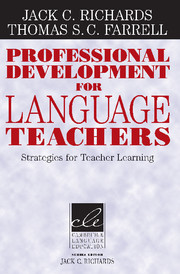Book contents
- Frontmatter
- Contents
- Series editor's preface
- Preface
- 1 The nature of teacher education
- 2 Workshops
- 3 Self-monitoring
- 4 Teacher support groups
- 5 Keeping a teaching journal
- 6 Peer observation
- 7 Teaching portfolios
- 8 Analyzing critical incidents
- 9 Case analysis
- 10 Peer coaching
- 11 Team teaching
- 12 Action research
- Appendix
- Index
12 - Action research
Published online by Cambridge University Press: 01 February 2010
- Frontmatter
- Contents
- Series editor's preface
- Preface
- 1 The nature of teacher education
- 2 Workshops
- 3 Self-monitoring
- 4 Teacher support groups
- 5 Keeping a teaching journal
- 6 Peer observation
- 7 Teaching portfolios
- 8 Analyzing critical incidents
- 9 Case analysis
- 10 Peer coaching
- 11 Team teaching
- 12 Action research
- Appendix
- Index
Summary
The nature of action research
Action research refers to teacher-conducted classroom research that seeks to clarify and resolve practical teaching issues and problems. The term “action research” refers to two dimensions of this kind of activity: The word research in “action research” refers to a systematic approach to carrying out investigations and collecting information that is designed to illuminate an issue or problem and to improve classroom practice. The word action refers to taking practical action to resolve classroom problems. Action research takes place in the teacher's own classroom and involves a cycle of activities centering on identifying a problem or issue, collecting information about the issue, devising a strategy to address the issue, trying out the strategy, and observing its effects. The nature of action research, however, with its cycle of observing, analyzing, acting, and reviewing, indicates that it is an activity that takes time to carry out and hence requires a considerable time commitment. For this reason, it is often more usefully viewed as a collaborative activity. The practical improvements action research seeks to bring about are not its only benefits, however. Through the process of planning and carrying out action research, teachers can develop a deeper understanding of many issues in teaching and learning as well as acquire useful classroom investigation skills.
Action research has the following characteristics:
Its primary goal is to improve teaching and learning in schools and classrooms and it is conducted during the process of regular classroom teaching.
It is usually small-scale and is intended to help resolve problems rather than simply be research for its own sake.
[…]
- Type
- Chapter
- Information
- Professional Development for Language TeachersStrategies for Teacher Learning, pp. 171 - 194Publisher: Cambridge University PressPrint publication year: 2005



